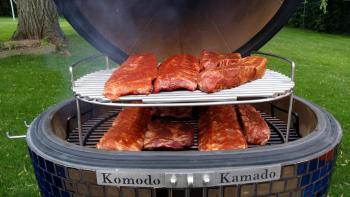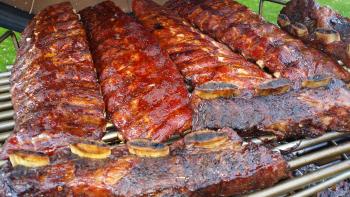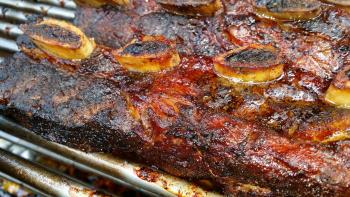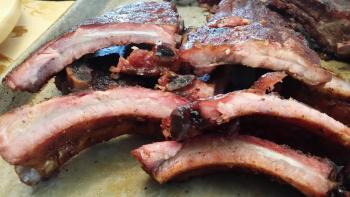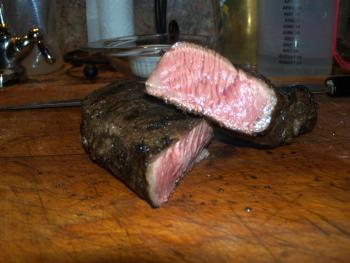Leaderboard
Popular Content
Showing content with the highest reputation on 06/22/2015 in all areas
-
I’ve wondered whether marinating ribs vs. putting a dry rub onto them had an advantage in how the ribs turned out in terms of moistness, bark, or texture. For Father’s Day I was planning on cooking some ribs, so I thought I’d answer my own question by testing this out for myself. I’m mainly interested to see how the bark and consistency of the ribs might be affected. I assume that the flavor profiles will be different. On the marinade side, I followed this recipe from Saveur magazine. I’ve cooked this once before, using an oven. (Please forgive me. We lived in an apartment at the time and I had no grill.) It turned out quite well, despite the lack of real smoking action. I put together the marinade yesterday afternoon and they sat in the refrigerator overnight. Here are the ribs in the Ziplock bag, marinating. On the dry rub side, I put together a rub based on Aaron Franklin’s approach, with some modifications. This rub is mainly 2 parts fresh ground black pepper, 1 part kosher salt, with a little bit of each of the following: garlic powder, onion powder, chile powder (see below), paprika, dry mustard, and brown sugar. Here are the modifications. Instead of the chile powder, I used the spice mixture from the marinade recipe because it was on hand from yesterday, it has a good amount of ancho chile and cayenne in it, and I didn’t want to waste it. The brown sugar is an addition to his rib rub approach. Aaron Franklin says he doesn’t like to use sugar for low and slow cooks because of the chance of burning. He says to add the sugar for cooking chicken because those cooks are faster, and so there’s less chance of the sugar burning. He also cooks on an offset smoker. I think that with a kamado, burning the sugar in the rub isn’t as much of an issue because the temperature control in a kamado is so good. In any case, everyone should watch his video on making rubs. It’s really terrific. Here’s the dry rub ribs, ready to go. And here are the two racks, side by side in Smaug. When I bought the two racks, they were pretty much identical in size and weight. It looks like the overnight marinade caused that rack to swell and change shape a bit. Smaug decided he wanted to be at 260ºF today, so that’s what I’m cooking at. Updates to come, but I plan on just letting them sit for the next five hours or so until they are done. Here are the ribs at about the three hour mark. Interestingly, both racks are starting to look the same as far as consistency and texture of the surface (beyond the presence of the spices in the dry rub rib, or course). I have about two hours left. One other thing I’d like to mention. I know that I had said that I was cooking at 250ºF because that’s where Smaug settled himself. After I posted that, I dialed down the vents a bit, and Smaug dropped down to 225ºF, which is where I originally intended to be. Good boy, Smaug. Here’s the final product. The ribs pretty much sat in Smaug for about five hours. I only disturbed them to take the in progress picture above, and tested their doneness by the bend test. The dry rub rack is on the top, and the marinated rack is on the bottom. Here are some close up photos to give you all an idea of what the ribs looked like. Dry rub rack: And the marinated rack: The interesting thing to me is that aside from the fact that the dry rub rack has spices sitting on the surface, the surface of both racks of ribs are pretty much the same. They both developed a bark, and both developed that nice mahogany color. In other words, if I had sprinkled the marinated rack with some spices at some point during the cooking, I doubt I could tell which rack was which based on appearance alone. I should also mention that there was no problem with the sugar in the dry rub burning, despite Aaron Frankin’s concerns about burning sugar in a long cook. I do think that’s because of the excellent temperature control that Smaug provided. Sugar can’t burn if it doesn’t get above its scorch point. Kamado cooking FTW! Here’s a comparison of the cross sections of the two racks. The dry rub ribs are on top, the marinated one is on the bottom. Both racks developed a nice smoke ring. It may look like that the dry rub rib has more of a smoke ring than the marinated rib, but that’s really just these two particular ribs. At other points in the rack, the dry rub ribs had less of a smoke ring, and the marinated ribs had more. In terms of texture and bite, it was a wash. The only tip off (outside of flavor) that you were eating the dry rub rack was that you could feel the presence of the spices with your tongue, but the meat was otherwise identical in texture and moisture. Here’s the glamour shot, with the ribs brushed with a little bit of BBQ sauce (here’s the recipe, and it’s the best recipe for BBQ sauce I have ever encountered). Marinated ribs on top, dry rub on the bottom. In terms of flavor distribution in the meat, both methods were pretty equivalent. Despite what the Amazing Ribs website says, the flavor of the marinade seemed to have no problem penetrating the meat, and even though the rack was marinated overnight, there seemed to be no ill effects of the acid components of the marinade precooking the surface of the meat. Having said that, this wouldn’t be the first time that the Amazing Ribs folks have misapplied science. In terms of overall flavor, we liked the dry rub better, but not by much. Both racks were delicious. It wasn’t really like one rack was “better†than the other. It was more like preferring one BBQ restaurant’s ribs to another. I have to mention that the marinated ribs were handicapped in the flavor comparison, as the original recipe calls for the marinated ribs to be brushed with BBQ sauce and then finished off at a high temperature. I didn’t do this step because I wanted to see if there was a texture difference between dry rub and marinating ribs, and the finishing step would have confused that. I’ve made the marinated ribs before, as I mentioned, and they did turn out better with the last step, and the taste of the marinated ribs with and without the sauce clearly showed that it was meant to be cooked and served with the sauce. Not all ribs are meant to be served without sauce. My conclusion is that outside of the flavor profile, there isn’t much difference between cooking ribs with a dry rub and cooking ribs with a marinade. Overall, a dry rub is a simpler to assemble and apply, so there’s an advantage to using a dry rub from that standpoint. On the other hand, there may be some recipes where a marinade is the only reasonable option. I’m specifically thinking about Asian-style recipes where you’ll want soy sauce as a flavor base, and there isn’t a dry rub version of soy sauce that I know of. So if you’re worried that a recipe for ribs calls for a marinade, and that might not be “real BBQ†because you’re not sprinkling on a rub, don’t be. Good food is good food, regardless of the method you took to get there. I realize that this contradicts a lot of what Amazing Ribs has to say about dry rubs vs. marinades. Like I said, this wouldn’t be the first time that Amazing Ribs got their science wrong. Finally, my wife made a batch of her cowboy beans as a side. All you need to know about this dish is that the first step in her recipe says, “Cook six pieces of bacon.â€2 points
-
Well today was rib day for my KK. I started last night with some rub for the ribs, I used four different rubs. I got up this morning lit my KK at 5:15am and let it heat sink till 6:30am then I put on the beef ribs. At 7am the short ribs went on followed by the baby backs at 7:30am. I can't believe after more then two hours at 225f the dome is cool to the touch. Through out the whole cook and heat sink about 7 hours the dome remained cool to the touch... just amazing. The ribs are done... The new rubs were great and I would recommend them for your collection. Cimarron Doc's Sweet Rib Rub Plowboys BBQ Yardbird Rub Eat Barbeque sweet rub Smokin Guns Mild rub2 points
-
It's not so much the damage that they can do (replaced several feeders over the years that the raccoon have destroyed), it's more a worry about my dogs. There's a dog door that leads out onto the deck so they can let themselves out. They have cornered both raccoon and possums on the deck (usually in the middle of the night!). So, I really don't want a middle of the night visit to the vet emergency room to get one of my dogs patched up from tangling with a critter!1 point
-
I've been picking off my 2 bushes for about 2 weeks. I only have another week or so of picking left. Blueberries are the one fruit deers won't touch. I tried peach trees. Forget it. The deers came one night and ate all the little peaches and left the pits on the ground. The next day they came and stripped every leaf off them. Pissed me off so the third day the riding lawn mower ate what was left.1 point
-
Cooking is an individual sport. I join forums to share ideas. My idea was a suggestion for experiments of cooking sous vide on the KK and possibly finding fun an neat new recipes for the KK. Sous Vide as I understand it means under pressure not under water. Water is just a good conductor of heat. My intent was to find new and wonderful ways to cook on my Komodo Kamado and to share the idea with forum members. The idea may well not work but I get to play with something I love doing. That is cooking on my Komodo Kamado. I don't accept that it can't go to bigger and better cooks. I like to cook and so does my Komodo Kamado. It Will Do - If I Will Do Are there new and different cooks for us to discover or have we maxed out. No breads. No Sweets = No ????? (fun) I have been with Dennis for most of the ride. I lived the suggestions and the improvements as they came into being. Hell of a story that someone should write. Best seller just sitting there for the doing. The Komodo Kamado Emerged from a hell of a lot of thought and work. It is not and never was intended to be limited, as such it is what customers have come to know and expect in a Komodo Kamado. It is not time to get off the bus and accept that there are no improved cooking methods or improvements in the Komodo Kamado future. How long since we have sent Dennis a suggestion of what we would like to see or have either on or with the Komodo Kamado. I'm a company man with no vote, no power, no stock or a chair at the table. I am also a owner of the best space age cooker in the world and a customer of the company owner who never hesitates to take my calls and listen to what I have say.1 point
-
I, personally, don't see a need for it. That's one of the beauties of SV cooking, is the uniformity of the temperature internally after several hours (steady state). The outside is the same temperature as the center. There is no thermal gradient to cause the "carryover" IT increase with normal exterior cooking methods (i.e., grilling or roasting). Once removed from the bath, the center temperature of the meat can only go down. That's the second big benefit of SV (to me anyway) is that it really hard to overcook food and is very forgiving on cooking times. As long as you don't overdo the high temp sear (typically 1 minute per side), the interior should stay pretty close to where it was coming out of the bath.1 point
-
Of the four Rubs, which ones did you like a lot ? How was Plowboys on ribs ? Like I said in another post, I like it on chicken. Nice looking cook.1 point
-
No, the tripod helps a lot and if I'm not using that I probably am using my elbows and a small f stop. Having gotten all those things going for the pix then if things need a little help try Photoshop or other photo enhancing program to do a little more enhancing. But you need to have the basics right or even a picture enhancing program is not going to give you the pix you want.1 point



